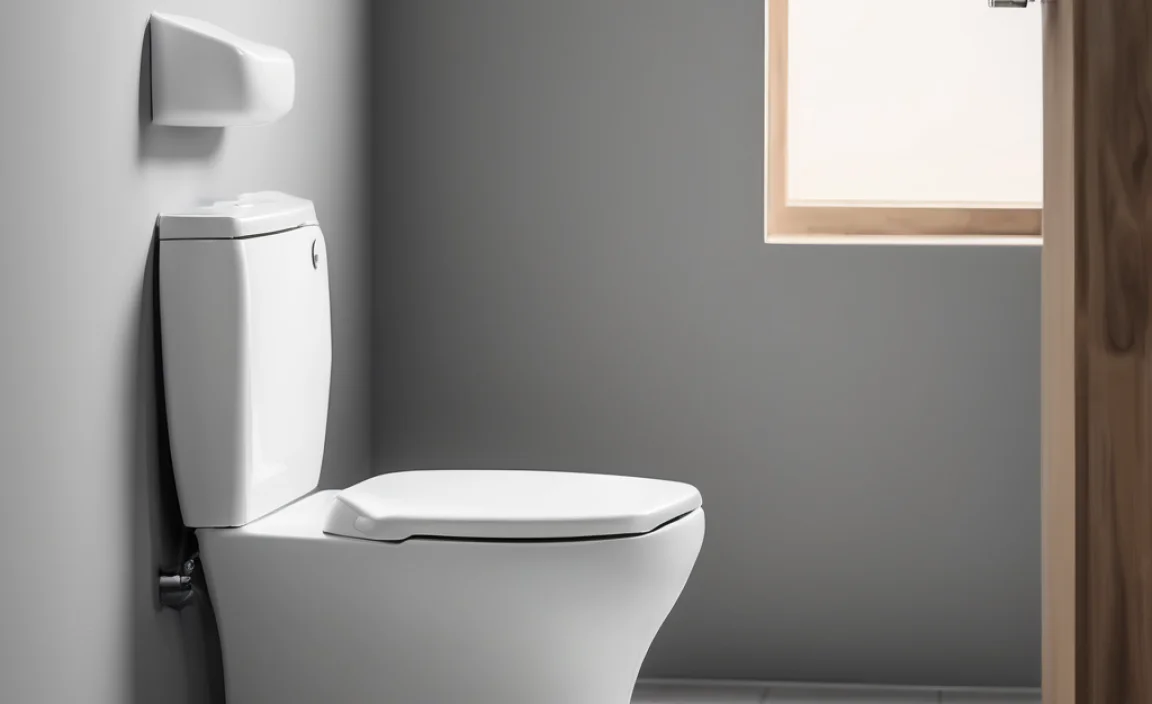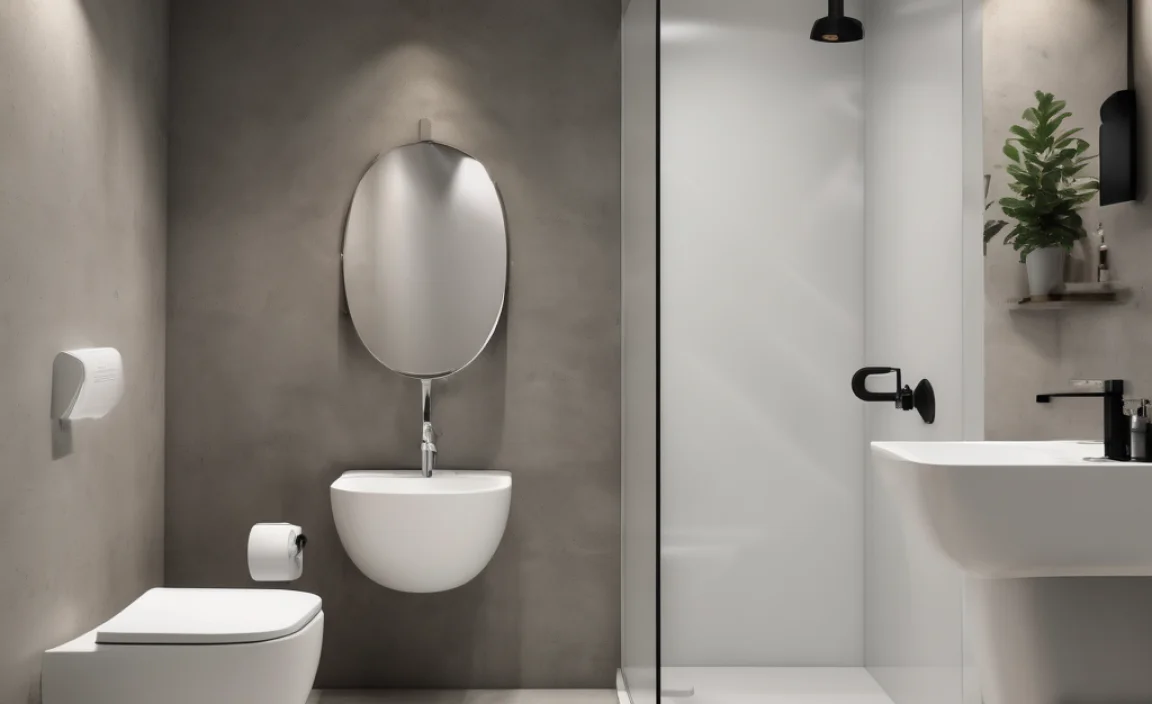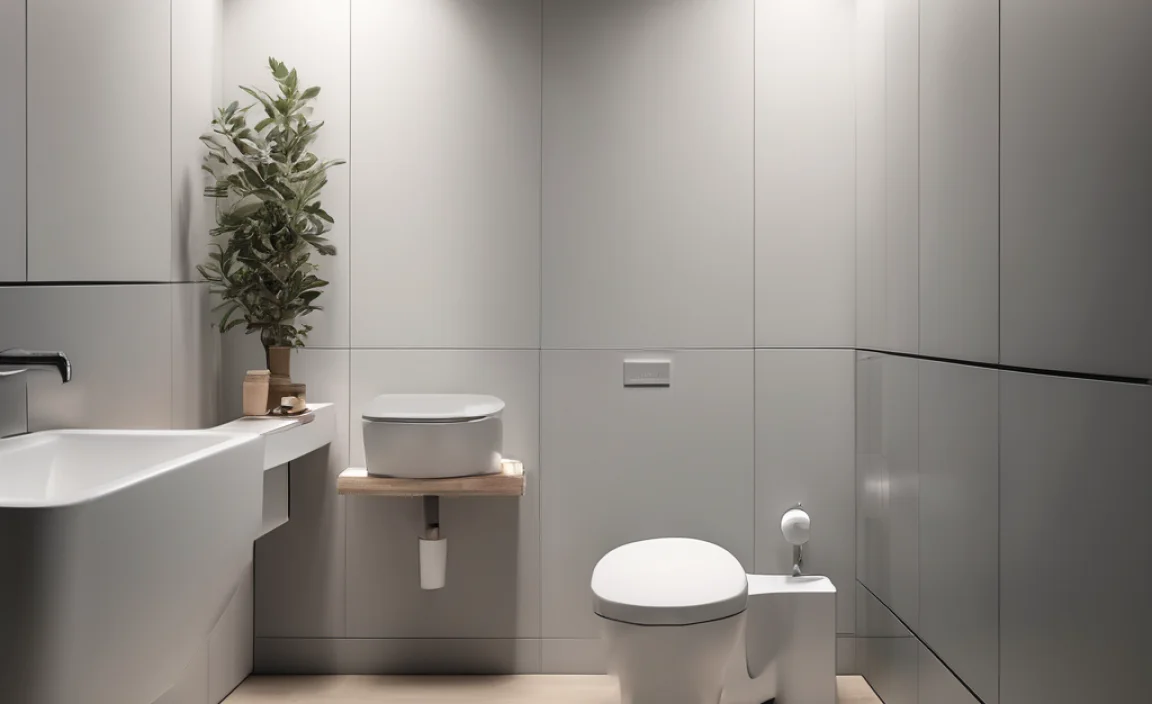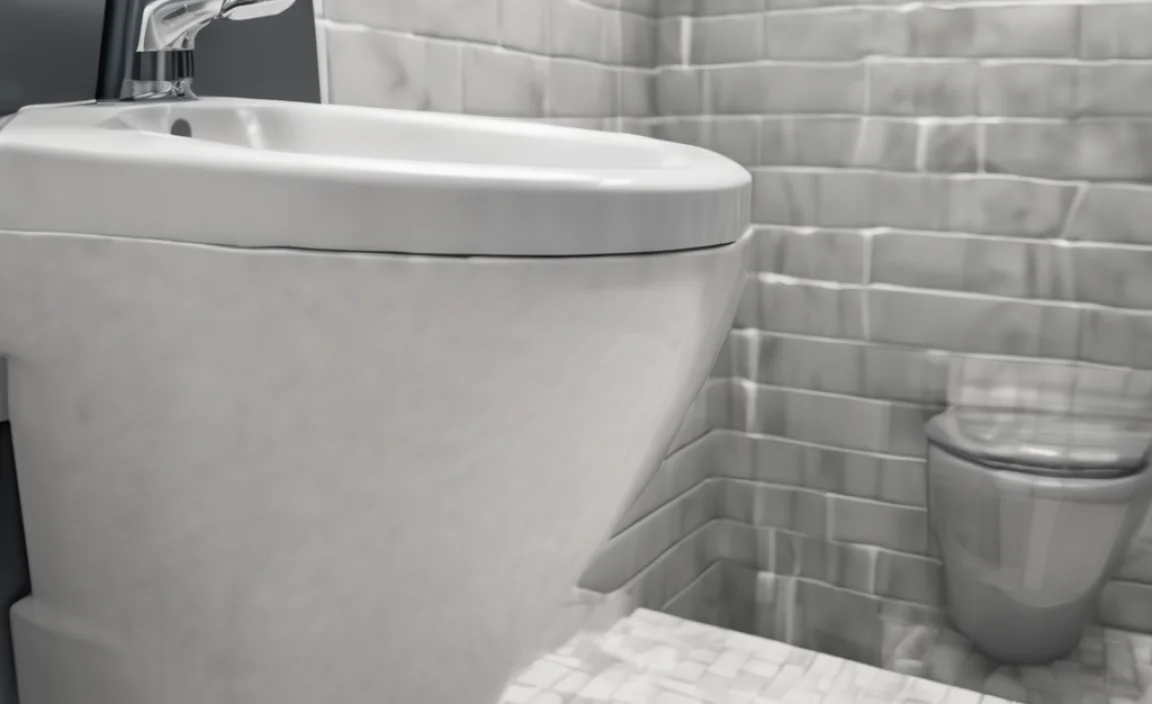Installing a wall-mounted toilet involves mounting a carrier frame inside the wall, connecting it to the plumbing, and then attaching the toilet bowl. This sleek, space-saving option requires careful measurements and secure connections. Don’t worry! With these step-by-step instructions, you can successfully install your wall-mounted toilet and enjoy its modern design and easy cleaning.
Wall-mounted toilets are a fantastic way to save space and add a modern touch to your bathroom. But let’s be honest, the thought of installing one can feel a bit daunting. It’s not your everyday DIY project, but with a little patience and the right guidance, you can absolutely tackle this.
This guide breaks down each step, from prepping the wall to the final flush. We’ll walk you through the tools you’ll need, how to safely handle the plumbing, and how to make sure everything is level and secure. Ready to transform your bathroom? Let’s get started!
Tools and Materials You’ll Need

Before you dive in, gather all the necessary tools and materials. Having everything on hand will make the installation process much smoother.
- Wall-mounted toilet and carrier frame: Make sure you have all the components.
- Level: Crucial for ensuring the toilet is perfectly aligned.
- Measuring tape: For accurate measurements.
- Pencil: For marking reference points.
- Drill with assorted bits: To create pilot holes and secure the frame.
- Wrench set: For tightening bolts and connections.
- Plumbing tools: Including pipe cutter, plumber’s tape, and pipe wrench.
- Screwdrivers: Both Phillips head and flathead.
- Safety glasses: To protect your eyes.
- Gloves: To keep your hands clean and protected.
- Shims: For fine-tuning the frame’s alignment.
- Drywall saw or utility knife: For cutting drywall.
- Cement board screws: To attach the cement board.
Step-by-Step Guide to Installing a Wall-Mounted Toilet

Follow these steps carefully to ensure a successful installation. Remember to always prioritize safety and double-check your work.
Step 1: Planning and Preparation
Before you start any physical work, proper planning is essential.
- Review the instructions: Start by reading the manufacturer’s instructions for your specific toilet model.
- Check wall compatibility: Ensure the wall can support the carrier frame and toilet. Wall-mounted toilets need to be installed on walls that can bear the weight of the toilet plus the weight of a person.
- Locate studs and plumbing: Identify the wall studs and the existing water supply and drain lines.
- Plan the layout: Decide on the exact location for the toilet, considering height and accessibility.
Step 2: Installing the Carrier Frame
The carrier frame is the backbone of your wall-mounted toilet. It supports the toilet and connects to the plumbing within the wall.
- Open the wall: Cut an opening in the wall large enough to accommodate the carrier frame. Use a drywall saw or utility knife to carefully cut along the marked lines.
- Position the frame: Place the carrier frame inside the wall opening. Align it with the studs and ensure it’s level both horizontally and vertically. Use a level to double-check your work.
- Secure the frame: Attach the carrier frame to the studs using appropriate screws or bolts. Make sure the frame is firmly anchored to the wall studs.
- Connect to plumbing: Connect the carrier frame to the water supply line and the drain line. Use plumber’s tape on threaded connections to prevent leaks.
- Test the connections: Turn on the water supply and check for any leaks around the connections. Tighten any fittings as needed.
Step 3: Preparing the Wall
After the carrier frame is securely installed, it’s time to prepare the wall for the toilet bowl.
- Install cement board: Cut cement board to fit around the carrier frame, leaving an opening for the toilet bowl. Attach the cement board to the studs using cement board screws.
- Apply waterproofing: Apply a waterproof membrane or sealant to the cement board to protect it from moisture. This is especially important in a bathroom environment.
- Tile the wall: Tile the wall around the carrier frame, leaving an opening for the toilet bowl. Ensure the tiles are level and properly aligned.
Step 4: Installing the Toilet Bowl
With the wall prepared, you can now install the toilet bowl.
- Attach mounting bolts: Insert the mounting bolts into the carrier frame, following the manufacturer’s instructions.
- Position the toilet bowl: Carefully align the toilet bowl with the mounting bolts and slide it into place.
- Secure the toilet bowl: Tighten the mounting bolts to secure the toilet bowl to the carrier frame. Be careful not to overtighten, as this could damage the toilet bowl.
- Connect the water supply: Connect the water supply line to the toilet bowl’s fill valve. Use plumber’s tape on threaded connections to prevent leaks.
Step 5: Final Adjustments and Testing
The final step involves making any necessary adjustments and testing the toilet.
- Check alignment: Ensure the toilet bowl is level and properly aligned. Use shims if necessary to make fine-tune adjustments.
- Test the flush: Flush the toilet several times to ensure it’s working properly. Check for any leaks around the connections.
- Install the flush plate: Install the flush plate according to the manufacturer’s instructions. This covers the access to the tank and operating mechanisms.
- Caulk around the base: Apply caulk around the base of the toilet where it meets the wall. This helps to seal the toilet and prevent water damage.
Troubleshooting Common Issues

Even with careful planning, you might encounter some issues during installation. Here are a few common problems and how to solve them:
- Leaks: Check all plumbing connections and tighten any loose fittings. Use plumber’s tape on threaded connections to prevent leaks.
- Toilet not flushing properly: Ensure the water supply is connected correctly and the fill valve is working. Check for any obstructions in the drain line.
- Toilet bowl not level: Use shims to adjust the toilet bowl until it’s perfectly level.
- Loose mounting bolts: Tighten the mounting bolts to secure the toilet bowl to the carrier frame. Be careful not to overtighten.
Safety Tips

Safety should always be your top priority when tackling any DIY project.
- Wear safety glasses: Protect your eyes from debris and splashes.
- Wear gloves: Keep your hands clean and protected.
- Turn off the water supply: Before working on any plumbing connections, turn off the water supply to prevent flooding.
- Follow manufacturer’s instructions: Always follow the manufacturer’s instructions for your specific toilet model.
- Ask for help: If you’re not comfortable with any part of the installation process, don’t hesitate to ask for help from a qualified plumber.
Cost Considerations

The cost of installing a wall-mounted toilet can vary depending on several factors, including the cost of the toilet itself, the carrier frame, and any additional materials you might need.
| Item | Estimated Cost |
|---|---|
| Wall-mounted toilet | $300 – $1000+ |
| Carrier frame | $200 – $500 |
| Plumbing supplies | $50 – $100 |
| Cement board and tiles | $100 – $300 |
| Professional installation (if needed) | $500 – $1500 |
Keep in mind that these are just estimates. The actual cost may be higher or lower depending on your specific circumstances. If you hire a professional plumber, factor in their labor costs as well.
Advantages and Disadvantages of Wall-Mounted Toilets
Before you commit to installing a wall-mounted toilet, consider the pros and cons.
- Advantages:
- Space-saving: Wall-mounted toilets take up less floor space than traditional toilets, making them ideal for small bathrooms.
- Modern design: They add a sleek, contemporary look to your bathroom.
- Easy to clean: With no base on the floor, it’s easier to clean around the toilet.
- Adjustable height: You can install the toilet at a height that’s comfortable for you.
- Disadvantages:
- More complex installation: Installation is more involved than with traditional toilets.
- Higher cost: Wall-mounted toilets and carrier frames can be more expensive.
- Requires wall modification: You’ll need to open up the wall to install the carrier frame.
- Potential for leaks: Plumbing connections inside the wall can be difficult to access if leaks occur.
Wall-Mounted Toilet vs. Traditional Toilet
Let’s compare wall-mounted toilets with traditional floor-mounted models to help you decide which is best for your bathroom.
| Feature | Wall-Mounted Toilet | Traditional Toilet |
|---|---|---|
| Space Saving | Yes, great for small bathrooms | No, takes up more floor space |
| Design | Modern, sleek look | Traditional, common design |
| Cleaning | Easier to clean around | More difficult due to base |
| Installation | More complex, requires wall modification | Simpler, straightforward installation |
| Cost | Higher initial cost | Lower initial cost |
| Adjustable Height | Yes, can be installed at desired height | No, fixed height |
FAQ Section
Q: Can I install a wall-mounted toilet myself, or do I need a professional?
A: If you’re comfortable with basic plumbing and DIY tasks, you can install a wall-mounted toilet yourself. However, if you’re unsure or dealing with complex plumbing, it’s best to hire a professional plumber to ensure a safe and correct installation.
Q: What kind of wall do I need for a wall-mounted toilet?
A: You need a strong wall that can support the weight of the toilet and the user. Typically, this means the wall must have sturdy studs and possibly additional reinforcement. Check the manufacturer’s specifications for weight requirements.
Q: How high should I install my wall-mounted toilet?
A: The standard height for a toilet is around 17 inches from the floor to the top of the seat. However, with a wall-mounted toilet, you have some flexibility. Consider the comfort and needs of the users when determining the height.
Q: What if I find a leak after installing my wall-mounted toilet?
A: First, turn off the water supply. Then, carefully inspect all the connections for any signs of leakage. Tighten any loose fittings. If the leak persists, you may need to replace the faulty part or call a plumber for assistance.
Q: Are wall-mounted toilets more expensive than regular toilets?
A: Yes, wall-mounted toilets typically have a higher upfront cost compared to traditional toilets. This is due to the additional components like the carrier frame and the more complex installation process.
Q: Do wall-mounted toilets save water?
A: Many wall-mounted toilets come with dual-flush options, allowing you to choose between a full flush and a half flush. This can help save water compared to older, less efficient toilets. Look for WaterSense-certified models.
Q: Can I replace a regular toilet with a wall-mounted one?
A: Yes, but it requires more extensive renovation. You’ll need to open the wall to install the carrier frame and modify the plumbing connections. It’s a bigger project than a simple toilet replacement, but it’s definitely possible.
Conclusion
Installing a wall-mounted toilet might seem like a challenging project, but with the right tools, careful planning, and these step-by-step instructions, you can absolutely achieve a professional-looking result. Remember to prioritize safety, double-check your work, and don’t hesitate to seek help from a qualified plumber if needed. Enjoy your modern, space-saving bathroom upgrade!





